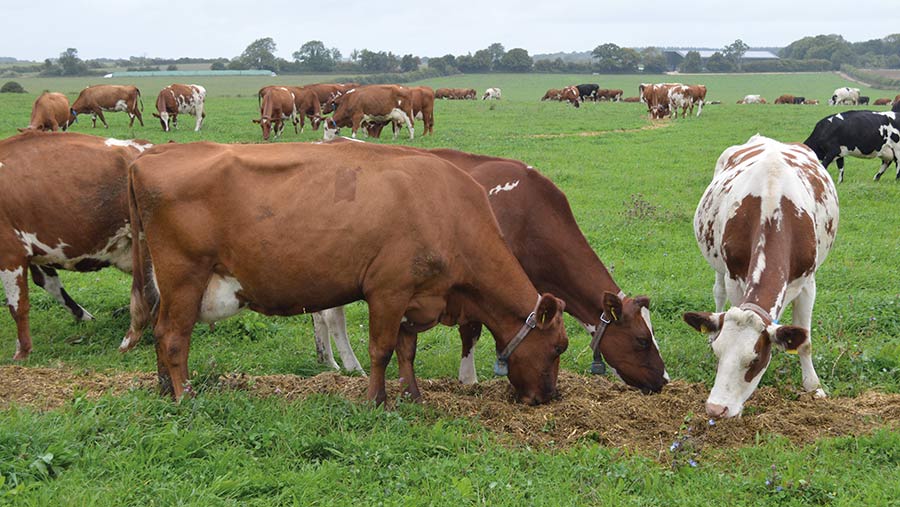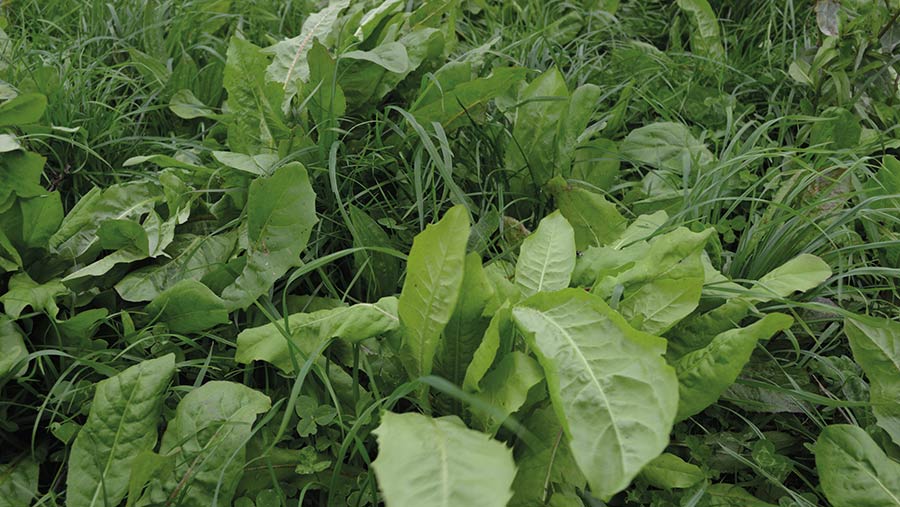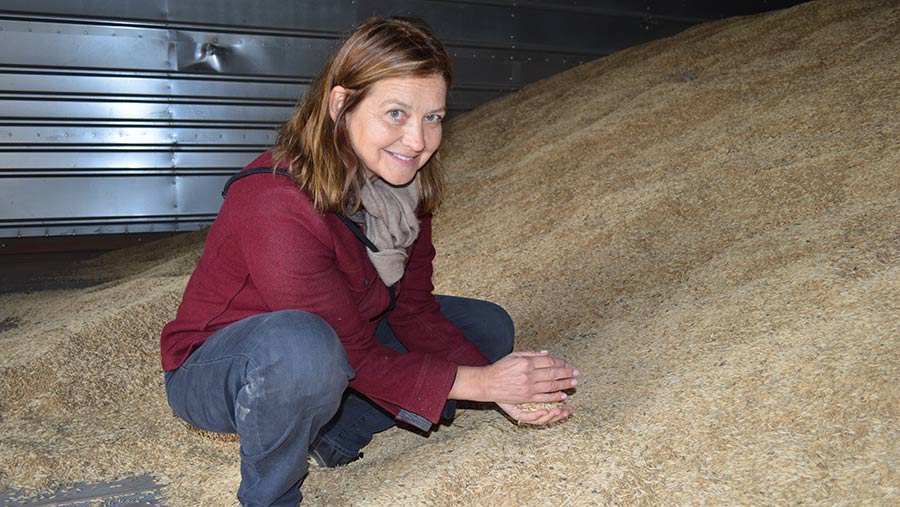Dairy herd introduction leads to better crop profit margins
 © MAG/David Jones
© MAG/David Jones Dairy cows grazing outside for 12 months of the year have helped kickstart an improvement in soils and arable crop yields on Sophie Alexander’s south Dorset organic farm, helping to offset the current sharp decline in direct farm subsidies.
Winter oat yields on her light chalky soils are approaching 6t/ha, while a spring bi-crop of wheat and beans sees the first hitting a valuable organic milling premium, while the protein-rich second crop helps to feed the cows.
See also: How Hampshire grower became Soil Farmer of the Year
Crop profit margins are higher now than when the farm was all arable and conventionally farmed with fertiliser and sprays.
The soils look darker and smell better, while deep-rooted herbal leys for cattle grazing are better able to survive a summer drought on her free-draining, loamy chalk soils.
“The cows are my fertiliser and they carry on producing fertiliser while also giving a wholesale product as well – milk,” she tells Farmers Weekly.
Financial factors
The switch to organic farming was prompted by purely financial factors as yields on the all-arable conventional farming system had stagnated.
Sophie says the organic way is simply more profitable and did not need high working capital in terms of inputs.
The farm’s rotation now consists of four to five years of a herbal ley to build fertility and soil health, which then helps feed three years of arable cropping of a spring wheat-spring bean mix, winter oats and then spring barley.

© MAG/David Jones
“The arable fields are rested, the soils structurally restored while the grazing and manures help build up the fertility for the next arable crops,” she says.
Sophie returned to the family farm in 2011 from a career in art and theatre production in London to take over 460ha of free-draining soils at Hemsworth Farm, Witchampton.
She took over from an arable farm tenant who had already started to turn the farm partly organic.
In the next three years, she observed that the organic crops gave a better margin than the conventionally farmed ones.
Also, the money saved on expensive inputs could be used to invest in infrastructure such as roads, fences and buildings.
Rebuild soil fertility
There was no preconceived idea to go organic, but once the financials collaborated that decision, she became more interested in organic methods.
Realising her light land, exhausted by continuous arable cropping, needed livestock to rebuild soil fertility, Sophie embarked on a path to become fully organic by 2017.
“These thin, chalky soils needs livestock to improve the health of the soil and help with fertility building,” she says.
Sheep were brought in from a neighbour to graze cover crops, but the biggest turning point was bringing young heifers in from a local dairy farm.
The introduction of the cattle brought a noticeable improvement in soil health and biology.
White clover-ryegrass leys were first used for grazing, but they looked to be doing little for the soil and so were quickly replaced by a 17-species herbal ley mixture.
This included deep-rooting chicory, plantain and red clover as key ingredients.
One of the big differences was that these leys grew better through the dry summers.
Sophie realised that what the farm really needed was its own livestock enterprise to improve the soil and make the farm financially secure.
This is crucial for the farm as the Basic Payment Scheme (BPS) of direct subsidies drains away from £233.30/ha in 2020 to zero by 2028.
“There is resilience in having two main enterprises – arable and dairy cows – to help with cashflow and plug the hole left by the disappearance of BPS,” she says.
VikingReds arrive
The result was the buying in of bulling heifers to start the farm’s own dairy herd of VikingReds in early 2020, with New Zealand herd manager Andrew Batty joining in September.
The spring-calving 250-strong dairy herd started producing milk in 2021, and crucially for soil health grazing for 12 months of the year.
Preparation for the first year of arable cropping after the herbal leys were made in late 2021.
First with old herbal leys grazed hard by youngstock and dry cows through the winter, and then a spring crop was planned to benefit from the soil enhancement and fertility building.
Although an autumn-drilled crop would potentially have yielded more, her light soils tend to retain more nutrients with an overwintering herbal ley followed by a spring crop.
Winter grazing is very valuable for the non-milking animals, such as youngstock and dry cows.
Through to the spring of 2022, some 30ha of herbal ley was ploughed, cultivated, drilled and rolled using a mix of the spring milling wheat variety Mulika and spring bean variety Victus.
All the arable work is done by a contractor, who drilled the bean first at 50-75mm depth and then the wheat following in the same drill lines at 25mm.

Sophie Alexander © MAG/David Jones
The advantage of this mix is that the wheat helps suppress weeds, while the beans appear to help improve the protein content of the wheat.
Sophie is planning to grow more than 30ha next spring.
“We were encouraged by the wheat-bean mix and it is the only way to grow beans organically,” she says.
Organic yields
Yield on the first wheat-bean mix was 3.5t/ha for organic wheat, selling at £380/t, and 1t/ha of beans valued at £600/t, and fed to the dairy herd.
There was little disease in terms of septoria in the wheat, and a small amount of chocolate spot disease in the beans.
“We are convinced we are getting a bigger margin than farming conventionally, and with BPS going, margin is king and not yield,” she says.
The second year of the arable rotation is Mascani winter oats following the similar arable preparation of plough-cultivate-drill-roll and has shown average yields of 4.3-4.5t/ha.
However, in a good year, the oat crop has yielded up to 5.6t/ha and sells at an organic price of £300/t to a local miller.
This is the most profitable arable crop on the organic farm and gives good weed suppression.
In the spring, cover crop seed is broadcast into the growing oat crop with a mixture used that includes forage rye, vetches and clovers.
Sophie admits it has been a challenge to establish these cover crops, but when successful they give good winter grazing for youngstock and dry cows.
The third arable crop is spring barley, which is undersown with a herbal ley mix and cut as whole crop silage.
This gives an early harvest and allows more time for the herbal ley to establish and be able to provide valuable grazing in the autumn.
Opting for VikingReds
The Scandinavian cattle breed VikingReds were chosen for their high health status and ability to graze for 12 months of the year with no winter housing and, therefore, no complex slurry systems.
The breed has its origins in three Nordic dairy breeds – Swedish Red, Danish Red and Finnish Ayrshire.
Sophie’s cows came from Sweden, which is free of TB and a number of other key cattle diseases.
The breed produces good beef calves, which are not a problem selling.
The spring-calving, parlour-milked dairy herd is in its second lactation and set for milk production of 4,200 litres a cow a year at 4.2% butterfat and 3.6% protein.
After being milked twice a day at the beginning of the lactation, the herd was moved to once-a-day milking by September, with the organic milk supplied to Arla.
The dairy herd is moved twice a day so any poaching and soil compaction is not severe, even on the light chalky soils, and a silage mix is fed to the cow in the fields through the winter months
“We were looking for cows with high health traits, low maintenance, which are good graziers, and are not too big an animal with good feet,” she says.
The contract manager for the dairy is Oliver Chedgey, who runs the Roaming Dairy.
He has been milking cows in his mobile parlour on the Kingsclere Estate in Hampshire since 2017 and also produces organic milk for Arla.

